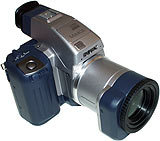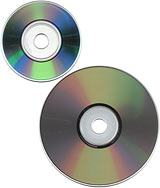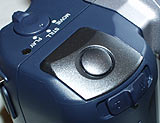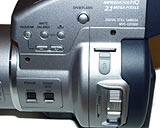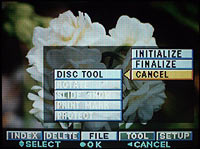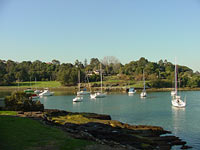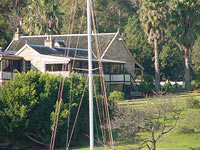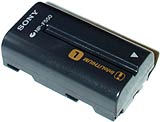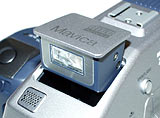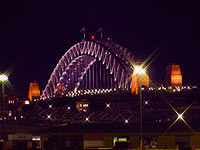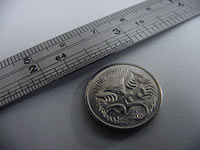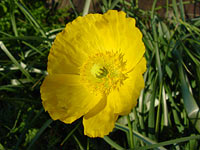
Sony Mavica MVC-CD1000 digital camera
Review date: 7 August 2000.Last modified 03-Dec-2011.
Storage costs turn a lot of people off digital cameras. Never mind that you can't get a digicam with image quality anything like that of a cheap 35mm for less than $AU1000; the "film" that digicams use costs a fortune too.
Most digital cameras use one or another kind of memory card to store their images. You can re-use the memory cards as often as you like, and review and delete images in-camera to make space without dumping pictures to a computer, but you can't get away from the fact that the cards still cost something like $AU5 per megabyte, and high quality high resolution images can be one to two megabytes in size.
Enter Sony.
Sony make memory card digicams - the CyberShot models, which use Sony's own Memory Stick cards - but they also make the Mavica line of cameras, which have disk drives.
Every Mavica up until now has had a simple floppy drive in the back. Images are written to disk as perfectly ordinary JPGs, so you can read them in anything that can understand an MS-DOS format floppy. Floppy disks cost, oh, maybe $AU7 for ten, and you get more than a megabyte of capacity per disk. And if you lose or destroy a floppy, hey, no big deal. A few pictures might have gone down the tubes, but the disks themselves are cheap enough that you can use them for drink coasters.
The recent Mavicas have been quite impressive cameras in their own right, too. The MVC91 and 95 models have very good lenses, good user interfaces, and reasonable manual controls. And, while they're not bargain basement cameras, they're not terrifyingly expensive by digicam standards either, considering their feature lists.
As a result, the Mavica line has what Sony's PR organisms call a "Legacy Of Universality". This is a fine example of calling a spade a variable fulcrum organically activated repurposable substance relocation device, but you get the idea. Tons of people have bought the things.
But the floppy drive's the limiting factor. When your storage is parcelled up into less-than-1.5-megabyte chunks, and you want to get at least a few pictures per disk, and you've got 1600 by 1200 maximum resolution - which is the Mavica FD95's top image size - you have to compress your images quite a lot.
What the Mavicas needed was another kind of cheap storage. Like, ha ha, a CD writer.
Even current CD writers can be finicky about their environment; they don't like vibration or power supply oddities while doing their thing. Older models were touchy enough about operating temperature that they really needed to be mounted in a separate external case. And, traditionally, CD writers have been unable to do the multiple-access kind of writing you need to store images one at a time. They're meant to write a disc in one, or a few, "sessions", not fill it slowly with dozens of separate files.
And, of course, a normal CD writer's too big to put in a camera. You could maybe slim one down to CD Walkman size, but you've still got to put that 120mm disc somewhere, and the result would be a digicam the size of a full-VHS camcorder.
But, wouldn't you know it, every single one of these problems has been overcome. And the result is the $AU2999 ($US1300) MVC-CD1000 - the world's first digital camera to use CD-Recordable write-once discs to store its images.
As digicams go, this is a big one - 137 by 131 by 212mm (5.5 by 5.25 by 8.4 inches). It's not heavy, though. The CD1000 actually weighs a hair less than a kilogram, thanks to is ultra-thin, super-tough magnesium alloy body panels (which feel sort of plasticky, but aren't) and similarly lightweight frame.
Just like the FD95, the CD1000's got 1600 by 1200 maximum resolution and a really impressive lens and various semi-manual features. But it's also got lots and lots of room to store its pictures.
Here's the back of the camera, open.
If you think that looks like a rather teeny CD, you're right. It's "CD single" sized - 77mm in diameter, versus the 120mm of a normal CD.
The CD single's a rare enough creature that a lot of people don't even know they exist. Actually, you've probably seen them a few times, but only in movies. When a scriptwriter can't think of a better focal point for a thriller than a nifty little optical disc that everyone in the movie wants, that nifty little disc is often as not a 77mm CD.
The 77mm format was conceived as the digital equivalent to the smaller-size microgroove LP records, but it never took off. Buy an audio CD "single" in a music store these days and you get a full-size disc, which'll either be mostly empty, or filled with remixes of the main track and the now-misnamed "B-side".
The reason for this is simple enough; 77mm CDs aren't much cheaper to make than 120mm ones. And the same goes for CD-Rs. There's not much market for discs that cost the same but hold less than a third of the data. The full capacity of a 77mm CD-R is about 180Mb, versus about 650Mb for a 120mm disc.
Unpopular they may be, but 77mm CDs are still part of the official specification, and most CD-ROM drives and CD players can read them just fine. If you've got a tray-load CD-ROM or DVD-ROM drive in your computer, open it up. There's probably a circular depression in the middle of the tray you can pop a 77mm disc into.
Even slot-load drives often support 77mm discs, these days; the ones in recent Macintoshes do, for instance. But don't assume that a given slot-load drive will, unless you know, because otherwise the results can be... awkward. Not as awkward as when a toddler plays post-the-letter with your slot-load drive and a fistful of cheese slices, but awkward nonetheless.
So that's the size-of-disc problem out of the way. If you can fit a floppy drive in your camera, it's not too much of a leap to replace it with a slimmed-down 77mm CD writer.
But there's still the lots-of-little-writes problem. It's solved by a technology called "packet writing", in which the data can be burned onto the disc without huge amounts of wasted space per file.
The inherent overhead of the packet writing system means the official per-disc capacity the CD1000 offers drops to 156Mb. And in the real world it can store even less per disc, as I'll mention shortly. But it's still got well over a hundred megabytes of useful storage per CD.
The down side of packet writing is that discs need to be "finalised" before you can read them on a PC without the special packet writing software installed. And the discs are still write-only, so you can't truly delete anything. "Deleting" files just marks them as not being there any more; the data's still on the disc, and you don't get the space back. But that's not much of a price to pay.
And speaking of the price to pay - how does $AU8 grab you?
That's the price Sony charge for a 77mm CD-R for the CD1000. The camera comes with five of them. A box of floppies gives you 14Mb of storage for $AU7; one 77mm CD gives you more than 120Mb for $AU8.
There's nothing special about the Sony CD-Rs as far as I know, so you ought to be able to use any 77mm disc in the CD1000, and pay a fair bit less per disc.
You can find stockists of 77mm CDs here in Australia if you hunt around. I've found a couple; read all about them here. Otherwise, hit the Web and buy from overseas.
The US discount outlets and you can sell ten-packs of generic-brand 77mm CD-Rs for $US20. $US25, if you want them in jewel cases. Plain no-case shrink-wrapped hundred-packs can be had for $US150 or so.
The CDR Outlet, for instance, has as I write this hundred-packs of 77mm CD-Rs for $US125.
A hundred discs might sound like a lot, but a case-less bulk-pack spindle of that many of 'em is only about as tall as a regular CD is wide.
With the CD storage, half-decent manual control including manual focus, a ton of zoom and a hatful of other useful features, the MVC-CD1000 is the most impressive non-professional digicam I've yet seen. Perfect it isn't; very interesting it is.
Displays
Yup, that's displays, plural.
The CD1000 has a pair of colour LCD displays - a 2.5 inch panel on the back, and a teeny LCD inside the viewfinder proper. Both displays show the exact same image, but (in one of the camera's many show-off points), to save power, the viewfinder display only turns on when you put your eye to the rubber surround. You can turn the bigger display on and off with a button on the back.
The viewfinder's the way to go to save power, but it's also a sharper display than the panel - it's got 800 by 225 dots, while the panel's only 560 by 220. Navigating the menus by fingering the four-way control button (press it in to select) while peering through the viewfinder is awkward, though. The screen's much more elegant for that.
There's a dioptre adjustment lever under the viewfinder that lets you compensate for pretty much anyone's eye focus oddities. The viewfinder and its proximity detector both work fine for people with glasses.
People who've become used to squishing their nose against the back of a camera may be alarmed by the overhanging-viewfinder CD1000 design. It makes the camera even longer, but more comfortable to use.
Both displays on the CD1000 show less than the full photographed frame - a bit more than 90%, as far as I could tell. This is a common enough feature on all sorts of cameras, as it gives you a bit of breathing space around the subject so you don't chop off a corner of something that you didn't quite notice. When you've got lots of resolution to play with, an under-sized viewfinder is not a problem.
Buttons, switches and plugs
The shutter button and zoom control are on the side of the (right-handed) hand grip, where you'd expect them. Rearward of the shutter button, there's the three-way mode switch, for still photography, video clips (of which more later) and playback modes. The other controls are all on the back and left side of the camera.
There are actually relatively few controls, thanks to the four-way control button on the back and the menu system it lets you access.
All of the more seldom used features are set up via menu selections; only the commonly used features have buttons.
The CD1000's also got four little rubber covers, over its input and output connectors. There's a flash cable connector on the left side, the DC power input on the side of the handgrip, and the USB connector (of which more shortly) and A/V output connectors on the base next to the tripod mount socket.
The A/V connector lets you connect the camera to a TV or VCR with composite video input. The A/V out has a mono audio connector, as well, and you can switch it between NTSC and PAL mode.
The video out works in the usual way - anything that appears on the camera's displays appears on the TV screen as well. You can thus review pictures, set up slide shows, frame shots or just fool around with video feedback.
Using it
When you put a fresh disc into the CD1000, you have to initialise it before you can use it. While it's initialising, the camera gives you a stern warning to put it on a flat surface and not disturb it. Initialisation only takes a few seconds, though. And then you're ready to rock and roll.
Ordinary disc writes don't give you the warning message, and it seems that you can use the camera as if it used solid state memory cards while you're taking pictures.
In use, the CD1000 feels surprisingly like a lot of other digicams. The odd storage method doesn't intrude. It's all quite straightforward. But it's not as fast to use as some cheaper cameras.
"Cycle time" is an important specification for digital cameras - it's the length of time between taking a picture, and the camera being ready to take another one.
Some digicams keep average cycle time down with buffer memory, that can store the uncompressed data for a few pictures while you take more. The camera saves the pictures as fast as it can while you're snapping away, and only if you fill the buffer do you have to wait for space to be made.
The CD1000, though, is an old-style camera as far as cycle time goes. It has to write the picture to disc before you can take another one, every time.
Fortunately, it's startlingly fast at doing this, when you consider how complex a CD writer is. Cycle time for full-resolution JPGs is only about five seconds, and it's a bit shorter for smaller images.
Lens lengthening
There's one feature of the CD1000 that'll really excite a lot of photographers - zoom. Lots of zoom.
Apart from the revolutionary storage device, the big deal about the CD1000 (and the MVC-FD95, with which it shares most of its features) is the monster 10X optical zoom lens. In 35mm-equivalent terms, this is a 39 to 390mm lens.
Hitting the zoom control on the CD1000 is something of a revelation, for people like me who are used to the lousy 2X or 3X zoom you get on many digicams - even quite expensive ones.
(In order to prevent server meltdown, I haven't put any original CD1000 image files online. Most of the example pictures have 200 pixel wide thumbnails that click through to 400 pixel wide larger versions, except where otherwise noted, and they've all been recompressed as well. If you're itchin' for some real example pictures, allow me to recommend the excellent Imaging Resource review of this camera, here.)
Here's an unzoomed shot from my Olympus C-2500L.
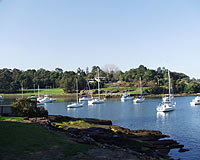
The C-2500L has 3X zoom. Zoom in all the way, and you get this:
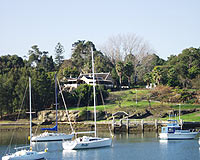
Now, here's an unzoomed shot from the CD1000:
Much the same as the C-2500L shot. Slightly less wide-angle to start with, actually, but it's only a small difference.
But the zoom keeps going... and going... and going...
...until you get this.
There isn't even much distortion, at either end of the zoom range; the physically long lens on the CD1000 means you don't get much in the way of barrel or pincushion distortion. The C-2500L, a much smaller camera, has quite noticeable distortion at the wide angle end.
Let's see that zoom again, shall we?

Zoomed out.

3X zoom.
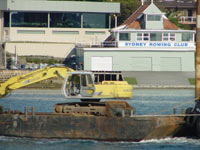
10X zoom.
A ton of zoom gives you a lot of shot-framing flexibility. This feature by itself makes the CD1000 quite seriously attractive to anybody who would like to take pictures of things that are neither the size of a Star Destroyer, nor sitting in the same room with them.
Actually, there's another 2X digital zoom on top of the 10X optical. But it doesn't count, since all digital zoom does is take a section out of the middle of the CCD image and scale it up.
Sony claim the digital zoom on the CD1000 uses a new "precision" interpolation technology to give better results than ever before, blah blah blah. The fact of the matter is still the same, though; you can't make data from nowhere. The CD1000's digi-zoomed shots certainly look as good as any I've seen, but they don't look any better than the middle bit of an un-digital-zoomed shot, scaled up to full size in any decent image editor.
Experienced photographers will, about now, be wondering what use a 10X optical zoom is without a tripod. It's really hard to hand-hold a large-focal-length camera and get clear shots. At 10X zoom you can pretty much read your heartbeat from the jumping of the image.
But not with the CD1000.
The bulge around the front of the CD1000 lens holds Sony's "Super SteadyShot" optical image stabilisation hardware (as well as serving as a stand for the front of the camera, on flat surfaces). The image stabiliser is spookily effective.
This is true optical image stabilisation, which is one of those systems which, intuitively, obviously can't work, but does. In response to the movement data from little accelerometers in the bulge at the front, servo-motors move the front and rear faces of a fluid-filled prism inside the lens. One face of the prism moves horizontally, one moves vertically. Between them, they "steer" the image onto the CCD.
Optical image stabilisation actually stabilises the image on the CCD. This is different from cheaper digital stabilisation systems, which have no moving parts; they look at the signal from the CCD, and algorithmically figure out how it's moving. Then they take a subsection of the CCD data, a "viewing window" if you will, and make that window move around as necessary to keep the image in it as stable as possible.
Digital image stabilisation reduces the effective resolution of the CCD, because you don't get to see the whole image sensor area; it also suffers from motion blur problems, because the image is still moving around on the CCD, and if it's moving fast enough the CCD won't be able to keep up. Optical stabilisation actually keeps the CCD image still.
In use, SteadyShot gives you an odd oily feeling as you move the camera around. Every move has a little lag, and small, jerky movements practically vanish. Essentially, SteadyShot means you can take pictures just as well at 10X - or even 20X - zoom as you can with the camera set to full wide angle.
There's a switch on the side of the camera to turn SteadyShot on and off; from what I can see, there's very little reason to turn it off, ever, unless you're really itching to save that last fragment of battery life.
Now, compared with some people's photographic toys, a 390mm-equivalent lens ain't much. But for a digicam, it's pretty darn impressive.
Difficult targets
With most digicams, taking pictures of things like passing planes is silly. Even if you've got 2000 by 1500 resolution, with a crummy 3X zoom you need that plane to be flying low enough to trim hedges in order for it to be more than a speck in the frame.
With 10X zoom, though, you don't need to lurk at the end of the runway.
I was taking these pictures far enough from the airport that, as a careful examination of this picture will show, the planes were just putting their wheels down as they passed. But, if you click the thumbnail above, you'll note that the CD1000 managed to lay more than 400 horizontal pixels on that plane.
To save the astronomers out there from getting out their calculators - at full optical zoom, the CD1000 manages about 340 pixels per angular degree. So it's actually possible to take not-terribly-exciting pictures of the moon with it. At 10X optical zoom, the moon's about 170 pixels wide.
Most digicams, even with a camcorder teleconverter screwed on, haven't a hope of taking a moon picture that's more than about 60 pixels across. You're not going to discover any black monoliths that way.
But even without a teleconverter, the CD1000 at full zoom's got enough resolution for you to see a bit of proper crater detail:

Sorry about the overexposure, astrophotographers. Yes, I know how to get a proper shot of the moon. No, I didn't do it properly. And yes, the moon had set by the time I got around to looking at my pictures. Sorry. You get the idea.
With SteadyShot turned on, it's dead easy to get shots like this without even a tripod.
Mind you, the monster zoom really isn't very useful for any target that isn't sitting still - or, at least, only flying past in a slow and predictable way.
When you semi-depress the picture-taking button and the CD1000 figures out its exposure and shutter settings, the viewfinder image freezes. It only freezes for a bit less than a second, but that's quite long enough for you to have lost that speedboat, sports car or Pleiadian warp-drive scout ship. And then there's another pause of about a fifth of a second between fully depressing the shutter button and actually taking the picture.
If you're using manual focus, the freeze-time drops to little more than half a second, but the picture-take delay's the same. With the narrow field of view full zoom gives you, you'll probably have lost the target and not be able to reacquire it.
Image quality
The CD1000 is, essentially, an FD95 with a different drive grafted on. The FD95 would be a generally excellent image-quality performer were it not for its high-ish compression. Well, here's the low compression version. And it's nice.
There's no choice of JPG compression level, but there are three resolutions - full 1600 by 1200, 1024 by 768, and 640 by 480. File sizes for the three run to 800-900kb for 1600 by 1200, 300 to 350kb for 1024 by 768, and around the 60kb mark for 640 by 480.
This would suggest that if you stick to the lowest resolution, you ought to be able to cram well over 2000 images onto one disc - maybe 2500 or more.
Or you might not. Sony quote only about 1000 images per disc for minimum resolution. This is because of the overheads created by the packet writing procedure.
The real disc capacity varies depending on how many files you save. The smaller the files are, the less real capacity you'll get. This is because the packet writing process is hamstrung by the basic inaccuracy of CD writing - CD writers can't start and stop on a dime. There has to be a space left in front of and behind each file that's written to the disc, to make sure that the next file written doesn't overwrite any data from the last one.
I filled a test disc with 155 files in five folders, which between them added up to only 122Mb of real data. From the "154Mb" nominal disc capacity, that's about a fifth of a megabyte of wasted space per file.
The amount of wasted space must, I suppose, vary with file size to some extent. if there's 200 kilobytes of overhead for every file, then if you're filling the disc with little 60 kilobyte 640 by 480 files, you'd only be able to fit about 600 of them in, not the more-than-a-thousand Sony quote.
In any case, for applications that don't need super quality, the lowest resolution brings the per-shot price down pretty darn close to zero. Even at $AU8 per disc, full-res JPG shots only cost five cents a pop.
Now, cameras with rewritable memory of course have no real incremental per-shot expenses. But their storage is still quite expensive. Let's say you've got a camera using, say, a 64Mb CompactFlash card. That card's yours for $AU270 or so, and it can hold maybe 80 images of the size of the CD-1000's full-res JPGs. To get to the five-cents-per-shot mark, you'll need to take 5400 pictures. After that, you're ahead. Whoopee.
Unlike previous Sony cameras, the CD1000 also has an uncompressed TIFF mode. JPG files use JFIF compression, which is "lossy" - it achieves small file sizes by throwing some data away. The more data you discard, the smaller the files get, but the lousier the image quality is. Use a format like TIFF that doesn't do lossy compression, and you make much bigger images, but lose no quality at all.
You actually can compress TIFFs, using non-lossy compression that saves a bit of space (typically about a third of the file size) without sacrificing any image quality. But TIFF compression is too demanding for any digital cameras I know of to do it, so you get completely uncompressed TIFFs. Which are Gargantuan.
Uncompressed TIFF size calculations are easy enough. Pixel height times pixel width times bytes per pixel. The 24 bit images saved by pretty much every digicam have three bytes per pixel, so for 1600 by 1200 you're looking at 5,760,000 bytes, which is 5625 kilobytes, which is pretty much exactly how much space the CD1000's TIFFs take up. Every single 1600 by 1200 TIFF a CD1000 writes will be precisely 5,761,428 bytes in size. Which means they take about 40 seconds to save to the CD.
You can use TIFF mode for 1024 by 768 and 640 by 480 as well, making roughly 2300 and 900 kilobyte files, respectively.
The CD1000 is, oddly, incapable of writing just a TIFF version of an image. It has to save a JPG version as well. I don't know why this is, but it adds another 800 kilobytes or so to the space taken up by each 1600 by 1200 TIFF-mode shot.
Mind you, this does make it easy to compare TIFF with JPG, and discover that it is very nearly impossible to tell the difference, thanks to the low JPG compression.
JPG compression ratios are, of necessity, approximate figures; the more detail there is in a picture, the less the JFIF algorithm will be able to compress it. Take a masterful shot of the inside of your lens cap and you'll get a rather smaller than average file. Which may be some consolation. Take a full-frame shot of a brightly lit and heavily decorated Christmas tree and you'll get a bigger than average file.
Since the CD1000's 1600 by 1200 JPGs are around 800 to 850 kilobytes in size, compared with 5.5 megabytes for the raw data, which means they've got approximately seven to one compression. The FD95 writes 1600 by 1200 JPGs not much more than 300 kilobytes in size; that means it's using something like 17 or 18 to one compression.
For consumer-quality shots, an FD95 can do a surprisingly good job, even if taking a lot of pictures does mean you're going to have to tote around a shoebox full of floppies. But the CD1000's compression's pushing up into the professional end of the market.
If you load a CD1000 high-res JPG into an image editor and look at the red, green and blue colour channels separately, you can just see the compression squares. A TIFF version of the same shot looks noticeably smoother. But this is quite esoteric, and perfectly irrelevant unless you want a super-smooth original to fiddle around with. If you're not going to do tons of processing of your images, the TIFF mode's a waste of time and space.
For comparison, my Olympus C-2500L at its HQ quality setting saves 1712 by 1368 images that average about 540 kilobytes in size. This works out as about 13:1 compression. It looks pretty good, but the compression's noticeable.
For shots I want to fiddle with, I use the 2500L's SHQ JPEG mode, which makes files 1650 kilobytes or so in size. Which is more like 4:1 compression, and eats up memory card space rather speedily. It's got a TIFF mode as well, but, again, the quality difference is so small that at 6883 kilobytes per picture, I don't get a lot of use out of it.
The CD1000's 1024 by 768 and 640 by 480 JPGs are about 325 and 60 kilobytes in size, respectively, which indicates 7:1 and 15:1 compression.
So 1024 by 768's a great mode to use if you want to fit more images onto a disc without losing very much quality. In 640 by 480, you can see the difference if you look closely. The images still aren't obnoxiously compressed, though, and the small file size is great to stretch your disk space, or if you just don't need anything better than medium-high compressed low-res mode.
The CD1000 has built-in image sharpening, but you don't have to use it. Sharpening's good, if you don't intend to do much or any post-processing of your photos in an image editing package later. A light sharpen will improve almost all shots. But sharpening's bad, if you're going to post-process. The sharpen is the last thing you're likely to do to the image, after twiddling its levels and colour balance and what have you.
There are two levels of sharpening you can activate in the CD1000, and they're both pretty subtle. This is better than the overblown super-sharpen that many cheap digicams do whether you like it or not, but it may somewhat disappoint point-and-shoot photographers.
You can also soften the image in two steps; again, the difference seems to be slight.
Other modes
The CD1000's got a selection of other shooting modes.
Text mode is one bit - pure black and white, not greyscale. It creates GIF files, not JPGs, and it's meant for document imaging. Even if you're in 1600 by 1200 mode it writes files only about 50 kilobytes in size.
But that's the end of the good news. You can't preview what the two-colour image is going to look like, so getting a decent result requires even lighting of the document and a bit of trial and error.
There's also an e-mail mode, which records a teeny 320 by 240 version of whatever you've photographed, as well as the full-size one.
And there's Voice Memo mode, which records a modified JPG file containing an audio track up to 40 seconds long. These JPGs will display fine on anything that understands JPG, but the audio's only available via Sony's software, or anything else out there that knows how to find it.
And then there are the video clip modes. The CD100 can record video clips, with sound, in 160 by 112 and 320 by 240, like previous Mavicas. But it's also got a 320 by 240 "HQ" mode, which has a higher frame rate and looks slightly less ghastly.
The clips are still small and brief, though. As with other Sony digicams, the maximum record time for the 320 by 240 modes is 15 seconds. 160 by 112 gives you up to a minute of recording, but at that resolution, you're not going to be winning any awards for cinematography.
This camera may have a ton of storage, but it doesn't have the RAM to record long clips, and so the video feature's still pretty much just a gimmick.
For some reason, when you play MPEG clips on the camera (as opposed to moving the files to a PC and playing them there) it displays the video for the two non-HQ modes in a small window on the screen - which makes it a very small window on the 2.5 inch panel. The playback size on a TV, via the A/V out, is in proportion. HQ clips play full-screen, though.
Moving files
When you want to get your images from the CD1000 into a PC, you've got several options.
It's not possible to just take a partially written disc out of the camera and read it in a computer, but you can do it if you finalise the disc. Finalising is a don't-bump-the-camera operation, like initialising, but it takes a bit longer. It turns the disc into a pretty much normal CD-R as far as a computer's concerned, and most systems should be able to read it just fine.
Finalising a disc doesn't mean you've finished with it. You can re-initialise it again and use any remaining capacity. The finalise operation uses up 13.5 megabytes of space, though, so don't think you're going to do it too often.
The CD-1000 uses ISO-9660 Level 3 format for its discs, which means that some older systems might not be able to read them. Some old CD-ROM and early DVD-ROM drives just can't read CD-Rs anyway. With current operating systems and current drives, though, it shouldn't be an issue.
Note to Macintosh users - apparently, to make ISO-9660 Level 3 discs legible in Mac OS 9 machines, you have to install the Adaptec UDF Volume Access Version 1.04 extension. I haven't tested this, though.
Alternatively, if you've got a Windows machine, you can access the camera via USB, without needing to finalise the disc.
To do this, you need packet writing software installed on the PC. The CD1000 comes with a special version of Adaptec's DirectCD packet writing software for Windows, and Windows USB drivers for the camera. Install DirectCD, plug in the camera and install the USB driver, and the camera becomes visible.
USB-equipped digicams that use memory cards behave, from the computer's point of view, as a USB memory card drive. Similarly, the CD1000 looks to the computer like a packet writing CD burner. So when you plug the camera into the computer DirectCD detects a new drive...
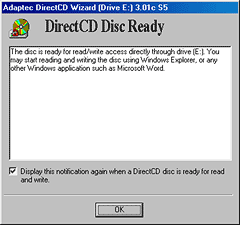
...and you're in business. You can initialise and write files to discs, and finalise them too, all from the PC, if you want.
When I first reviewed this camera, there was no Windows 2000 USB driver; Sony provided a superpolylingual piece of paper with four helpful URLs on it, none of which seemed to have the driver. Now that I update this review, there are drivers for all USB-capable Windows flavours (USB doesn't work at all in Windows NT); I'm told that the Windows 2000 driver works fine in WinXP. You can get the drivers from various Sony sites including this one, and in Windows XP, all you need is the driver. WinXP handles packet writing itself, so you don't need DirectCD.
Directory listings and other basic operations on the Mavica "drive" are sluggish - though not intolerably so - but the USB file transfer speed's quite respectable. You can move the thick end of a megabyte per second.
Sony helpfully provide an adaptor ring that you can click a 77mm CD into, to make it fit in full-size-disc-only drives. I'd still need a stiff drink or two before I stuck the adaptor into a slot-load CD-ROM drive but it'll be fine for old tray-load or caddy drives that can't otherwise deal with 77mm discs.
Software
Along with the disc containing DirectCD and the USB driver, there are a couple of other software CDs. You get Sony's own Picture Gear Lite, and MGI's PhotoSuite and VideoWave image and movie clip editing packages. The MGI programs come for both Windows and Mac; Picture Gear is Windows-only.
If you can't run Picture Gear, you're not missing much. It's yet another picture organising program, essentially. It can also make labels, and stitch images together into panoramas, but neither of these functions are impossible to find elsewhere.
Power
The CD1000 runs from a 1500 milliamp-hour 7.2 volt NP-F550 lithium ion battery pack. The pack is one of Sony's "InfoLithium" units, and it lets the camera give you a good idea of how much longer the battery will last at the current rate of consumption, via its on-screen display.
You get an AC-to-DC adaptor with the camera; the power supply charges the battery when the adaptor's plugged in and the camera's turned off. From dead flat it takes about 150 minutes to get a "normal charge", whereupon the charge light turns off, and about another hour to get a "full charge", with the battery tippy-top full.
You can get separate battery chargers and spare batteries as well, of course, but InfoLithium packs aren't cheap. US discounters are selling NP-F550s for $US45 or so, so $AU100 isn't out of the question here. To get the same amount of energy worth of nickel metal hydride rechargeable AA cells, such as are used by many other digicams, you'd need to buy seven of 'em, which would cost about $AU30.
One charge, however, will give you a genuine hundred minutes of continuous operation of the CD1000, or maybe two hours with judicious use of the LCD panel. So you don't necessarily need a spare battery at all.
Flash
The pop-up flash on top of the CD1000's small, but effective. The camera doesn't seem to have the flash metering problems of cheaper Sonys, which tend to overexpose. Like the cheaper cameras, though, the CD1000 lets you boost or cut the flash intensity.
There's a red-eye reduction pre-flash mode, as well as the usual fill flash setting to tell the flash to fire whether or not the camera thinks it needs it.
There's a flash mount on the top of the CD1000, but it's just a place to latch a flash on, not a proper hotshoe with contacts. But there's a flash signal output jack on the left side of the camera. You can't use any plain PC cord-equipped flash you like; you have to use Sony's own optional flash for the CD1000, the $AU229 ($US120) HVL-F1000 (which also works with lesser Mavicas).
Night shots
The CD1000 has both Aperture and Shutter Priority modes, in which you set the aperture or exposure time you want, and let the camera figure out the other settings to match. There's no full-manual-control mode, though.
The lens aperture can be set between f/2.8 to f/11, and there are shutter speeds from 1/500 to eight seconds. But you can only pick the really long exposures in Shutter Priority mode.
Since someone had rudely parked a Buran next to my office, I took a couple of night-time pictures of that.

(Click this thumbnail for the full-sized original image, not the crummy 400 pixel wide version that was originally
there.)
The major problem with shooting long exposures with the CD1000 isn't its sensitivity. It's the viewfinder. Without an optical viewfinder, you just can't see dim things. You have to guess at your image framing, going from experience and whatever bright elements there are in the scene.
This isn't just a problem when shooting genuinely dim things, like this shuttle, which wasn't nearly well enough lit for a person sitting on the wing to be able to read a book. It applies to ordinary dim indoor shots, as well. If you want to take pictures in a moodily candlelit room, you're in trouble.
Autofocus is also a problem in dimly lit situations, because the CD1000 doesn't have an autofocus illuminator. My C-2500L has two alarmingly bright amber LEDs under the lens barrel that it shines on its targets when there's not enough light to see by; many better 35mm cameras use their flash to pre-light difficult scenes. The CD1000 doesn't do anything to help it see, so its low light focus performance isn't great.
Fortunately, this camera has manual focus. Click the switch on the side, and you can turn a fly-by-wire electronic-control ring on the end of the lens to get the focus you want. You're not really directly turning anything inside the lens, but it's still much better than the button-clicking manual focus many digicams use, if they have manual focus at all.
Manual focus of high-resolution devices through a not-so-high-resolution video viewfinder has always been a problem. The CD1000 deals with it by using its digital zoom. When you select the manual focus mode and move the focus ring, you instantly get 2X digital zoom on the middle of the image, to let you get the focus really sharp. Stop turning the ring and the image pops back to full frame.
When there are plenty of little bright things to frame and focus from, though, the framing and focus problems go away.
I'm not using a starburst filter, here. The X-shaped highlights on everything bright are a natural artefact of the lens. If you like 'em, they're great. If you don't want 'em, you're going to be doing a lot of image editing.
The long exposure pictures show plenty of "hot pixels" - over-sensitive CCD pixels. Hot pixels don't show up in exposures of normal length, but if a pixel is only 1% brighter than it should be in a 1/100 second exposure, it'll be eight times brighter than it should be on an eight second exposure. Hence, little light dots.
I've seen much worse hot pixel problems than this, though.
Apart from problems seeing what you're shooting, the CD1000 does quite well with difficult targets, be they too dark or too bright. And there's a technical reason for that.
Colour depth
This is a 36 bit camera. It has 12 bit colour depth for each of the red, green and blue colour channels. Most consumer and "prosumer" digicams only have eight or ten bits per channel, for 256 or 1024 possible intensity levels, but the CD1000 has 4096 levels per channel.
But, I hear you ask, the CD1000 only writes 24 bit images, so what's the point?
JPG images can only be 24 bit (or eight bit greyscale). It's possible to save 48 bit TIFFs, but the CD1000 doesn't, which is just as well because a lot of software can't load them. But the extra bit depth still has a purpose.
With 4096 intensity levels, the CD1000 can, in theory at least, extract a full eight bit intensity range from one-sixteenth of its total possible intensity range. This means it could take only the darkest sixteenth, or the lightest, and still make an image without any unsightly "banding" of distinct colours where there's supposed to be a smooth gradient.
This has to give the camera considerable flexibility in unusual lighting conditions. If the camera notices that the light levels of the subject at a given shutter and exposure setting are such that, say, only the bottom third of its intensity range is used, no problem. It can easily sample a smooth 24 bit image out of that third.
Likewise, in a really bright scene when the camera might really want a faster than 1/500 shutter speed, but doesn't have it, it can deal with a CCD that's delivering an image with no signal below the halfway mark of its intensity range. No problem; you can still get a shot with white whites and black blacks, without burning out of the bright bits or creating impenetrable blocks of nothing in the dark ones.
In other words, when the shutter speeds and aperture settings available to the CD1000 aren't enough to get an ideal shot - particularly when you've locked it to a particular shutter speed or aperture - it can still take a good picture.
Up close and personal
You want macro mode? I got yer macro mode right here, pal.
The CD1000's macro mode works from 2 to 25cm away from the camera; 25cm is the minimum focus distance for non-macro mode.
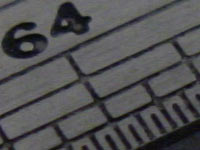
Here's a little full-scale chunk of the image. Sixty-fourths of an inch, folks.
There are lots of digicams these days that can take pictures with the lens practically resting on the subject. This may be a neat party trick, but it's not actually very useful, because the lens ends up casting a shadow on the subject, and the flash is of course completely useless. The above shot was taken with light from all directions; with normal lighting, it'd be nastily dark.
Better digicams can use zoom and macro at the same time, allowing you to move back from the target The CD1000 is able to do this, but the more you zoom, the less depth of field you get.
This shot was taken at 5X zoom - which is the most the camera can support without losing focus - and only the middle of the image is properly focussed. But the lens-shadow's gone.
If you're aiming straight down at a pretty much flat subject, this isn't a problem at all. And, of course, most macrophotography (which, strictly, means any shot that makes an image inside the camera that's bigger than the actual object being photographed, but colloquially just means "really close-up stuff") isn't right up at the range limit. It's just your common or garden close-ups, like this...
...and the CD1000 does an excellent job for these shots.
Documentation
The CD1000's manual is up to Sony's usual high standard - clear diagrams, all English, and some peculiar warnings for the stupid. I don't know why anybody out there would actually decide to try to use the CD1000's drive door as a carry-handle, but the manual warns you not to.
Mind you, it doesn't tell you not to expose the CD1000 to open fire or flame.
You also get separate manuals for DirectCD and the other camera software.
Other features
The CD1000 has a 3:2 aspect ratio mode, in case you want to take "photo-shaped" shots. Its standard resolutions are all 4:3 aspect ratio - they're four-thirds as wide as they are high, just like a TV screen or computer monitor. This aspect ratio is also expressed as "1.33". 3:2 aspect ratio, in the same way, can be expressed as "1.5".
Standard 35mm film has a 1.5 aspect ratio, but most digicams don't. Since the CCD technology they're based on is mainly used in video cameras, their CCDs often have the TV-type 1.33 aspect ratio.
The CD1000 achieves a 1.5 aspect ratio by discarding a bit of the top and bottom of the frame - in 3:2 mode, you get 1600 by 1072 images. 3:2 isn't available for the lower resolutions.
The CD1000 has the usual suite of in-camera image manipulation features. You can rotate images, crop them, delete them and so on. But because it's working with write-once media, every change you make eats up some more disc space, and nothing is ever really deleted - it's just marked as not there any more in the table of contents, and could be recovered with appropriate software.
You can "protect" images from deletion, too, and there's also compatibility with the Digital Print Order Format (DPOF) standard, so you can put a "print mark" on particular images, which says that those are the ones you want printed. Then you can drop your disc off at a printing place that understands DPOF, and you don't need to include a note telling them which shots to do.
The chunky lens has a proper 52mm filter thread on it, so you won't have to futz around with step-up rings to fit normal camera filters on. As always with integrated-lens cameras, it's a very good idea to get at least a cheap UV filter with the camera, and stick it on the minute you take the thing out of the box.
UV filters can somewhat improve daytime shots from film cameras, because film is ultraviolet-sensitive. But they do three-fifths of bugger all (a technical term) for the image from a digital camera, because CCD image sensor sensitivity falls off towards the blue end of the spectrum, and approaches zero for ultraviolet. But a UV filter is probably the cheapest filter you can find, it won't degrade your digital images in any way, and it will protect the lens from scratches.
Get a big scratch on the lens of even a $AU3000 integrated-lens digicam like the CD1000, and you're likely to find it's cheaper to buy a new camera than to get the old one fixed.
So use a UV filter.
As well as the two Priority exposure modes, the CD1000 has a few other camcorder-style exposure options. The Twilight and Twilight Plus modes drop the viewfinder refresh rate and increase the camera's sensitivity; they tell the camcorder to use longer than usual exposures, and give you the best view you're going to get of dim subjects.
Landscape mode locks focus at infinity; Panfocus mode lets you quickly shift between distant and close subjects. And there's spot metering as well, so you can set the exposure settings according to the middle of the frame, not the whole image in general.
There's also a position sensor, which detects which way around you're holding the camera and correctly aligns the pictures you take. Rotate the camera 90 degrees and take a "portrait" shot, and you won't have to rotate the image later to get it the right way around. You can disable the sensor if you're shooting pretty much straight up or down, to stop it from making whimsical decisions about how to orient the pictures.
And, like every decent digicam, the CD1000 lets you set the white balance - the colour that's defined as white. By default it uses its automatic mode, which is generally pretty good. But it's also got canned Indoor and Outdoor settings. And you can just point it at a white thing and hit the set-balance button, too.
You can't use the flash when you set the white balance, but this isn't likely to bother most photographers.
There's also a self-timer, as usual, so you can get yourself into the picture. Unlike my C-2500L, though, there's no remote control, so you can't trigger the camera manually from across the room. Sony must have run out of camera surface area, or something.
Oddities
There's not much to dislike about the CD1000 really, assuming you can afford it. But it has its quirks.
For instance, it's still got the "anything goes" autofocus of various previous Sony digicams. It'll try to focus, but if it fails, it'll still let you take the picture. You don't get the green dot at the top of the display that indicates successful autofocus, but that's the only difference.
This is really more of a feature than a bug, because it lets you judge for yourself whether the focus is good enough to take a shot. But if you just jam the button down and hope for the best because you want to take a picture of your kitten being adorable right now, failure to focus will probably give you a five cent fuzzy mess written to the disc.
You also get a selection of the usual good-for-nothing-much camcorder-style "effects" - negative, sepia, black and white and solarised. None of these are much use; black and white mode doesn't even give you significantly smaller files.
The control button you use to navigate the CD1000's menus is also a bit of a pain. It's too smooth and a bit too small, if you ask me, and it makes the menu system more annoying to use than it should be.
The tripod mount plate at the bottom of the camera might be an issue, too. It's not a plate at all, really; it's much smaller than the mount points on most cameras. The thread's metal, so you can crank the mounting screw on hard, but the camera may still wobble a little.
And Sony quote the MVC-CD1000 as being a "2.1 megapixel" camera. Well, it may have 2.1 million pixels on its CCD, but it only outputs 1600 by 1200 images, in maximum resolution, and that looks like 1.92 megapixels to me.
No matter; 1600 by 1200 is still a perfectly acceptable resolution. More pixels might be nice, but this camera's got plenty else going for it.
Overall
The CD1000 doesn't really feel like a still camera. It's more like a cross between a video camera and a weapon made illegal by Starfleet on humanitarian grounds.
If you're shopping for a digicam-as-techno-toy and you can afford the $AU2999 price tag, the CD1000 is an obvious winner. And it takes rather good pictures, to boot.
But if you're after real manual controls, you won't find them. And the CD1000's performance on dim subjects is hobbled by its poor viewfinder sensitivity and lack of a focus illuminator.
Most people don't want full manual control, though, and in normally lit rooms the CD1000 works very well indeed. Its zoom is phenomenal and useable without a tripod, its user interface is OK, and CD-R as a storage method has a lot going for it, even if impressing your friends isn't on your list of priorities.
If you hopped in a time machine and went back a hundred years, there are all sorts of things you could take with you to prove you were from the future.
The MVC-CD1000 is a gadget that'd convince people even if you only went back five years.
If you're shopping for a prosumer digicam, you owe it to yourself to check this thing out.
Recommended.
Review camera kindly provided by Sony Australia
Sony's page for the MVC-CD1000
Imaging Resource's review of the MVC-CD1000 (lots of sample pics!)
